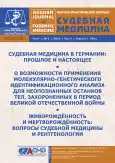Методика диагностики пола взрослого человека по анатомо-морфологическим особенностям черпаловидных хрящей
- Авторы: Калимуллин Р.Р.1, Звягин В.Н.2
-
Учреждения:
- Областное бюро судебно-медицинской экспертизы
- Российский центр судебно-медицинской экспертизы
- Выпуск: Том 7, № 2 (2021)
- Страницы: 83-87
- Раздел: Оригинальные исследования
- URL: https://journals.rcsi.science/2411-8729/article/view/122401
- DOI: https://doi.org/10.17816/fm392
- ID: 122401
Цитировать
Полный текст
Аннотация
Актуальность. Одним из основных вопросов общей идентификации личности является определение пола обезличенных или фрагментированных тел. В судебно-медицинской литературе имеются единичные сообщения о половом диморфизме хрящей гортани, среди которых черпаловидные хрящи отсутствуют. Публикации носят морфометрическую направленность, практические аспекты диагностики пола в них не рассматриваются, что и обусловило цель настоящей работы. Цель исследования — разработать методику определения пола по обладающим половым диморфизмом анатомо-морфологическим признакам черпаловидных хрящей взрослого человека. Материал и методы. Исследованы анатомо-морфологические особенности черпаловидных хрящей от 160 лиц мужского (80) и женского (80) пола в возрасте от 20 до 78 лет. При визуальном исследовании выявлены различия, связанные с половой принадлежностью по 9 признакам. Достоверность полового диморфизма признаков проверена с помощью критерия Хи-квадрат и коэффициентов пропорциональности. Результаты. Выяснена информационная значимость признаков и проведена индивидуальная оцифровка наблюдений по формуле. Установлена возможность определения пола по черпаловидным хрящам в 93,75% случаев, в остальных 6,25% обоснован вывод о невозможности решения этой задачи по заданной совокупности признаков. Заключение. Разработанная методика определения половой принадлежности обладает высокой точностью и может найти применение в диагностике пола при производстве судебно-медицинской экспертизы гортани разрушенного трупа.
Полный текст
Открыть статью на сайте журналаОб авторах
Рафкат Равильевич Калимуллин
Областное бюро судебно-медицинской экспертизы
Автор, ответственный за переписку.
Email: kalim_raf@mail.ru
ORCID iD: 0000-0001-9707-912X
Россия, 625032, Тюмень, ул. Юрия Семовских, д. 14
Виктор Николаевич Звягин
Российский центр судебно-медицинской экспертизы
Email: oil@rc-sme.ru
ORCID iD: 0000-0003-1972-3615
д.м.н., профессор
Россия, МоскваСписок литературы
- Полетаева М.П. Возможности установления пола по анатомическим особенностям щитовидного хряща человека // Судебно-медицинская экспертиза. 2017. Т. 60, № 4. С. 21–24. doi: 10.17116/sudmed201760421-24
- Золотенкова Г.В., Шигеев С.В., Полетаева М.П., Гульгельдиев Г.Г. Возможности установления пола по антропометрическим параметрам перстневидного хряща человека // Судебно-медицинская экспертиза. 2021. Т. 64, № 1 С. 24–28. doi: 10.17116/sudmed20216401124
- Звягин В.Н. Методика краниоскопической диагностики пола человека // Судебно-медицинская экспертиза. 1983. Т. 26, № 3. С. 15–17.
- Garmus A. Pelvic bones in forensic medicine. Vilnius: Baltic medico-legal association; 1993. С. 128–130.
- Rogers T., Saunders S. Accuracy of sex determination using morphological traits of the human pelvic // J Forensic Sci. 1994. Vol. 39, N 4. P. 1047–1056. doi: 10.1520/jfs13683j
- Rogers T. A visual method of determining the sex of skeletal remains using the distal humerus // J Forensic Sci. 1999. Vol. 44, N 1. P. 57–60. doi: 10.1520/jfs14411j
- Фениш Х. Карманный атлас анатомии человека. Минск: Вышэйшая школа, 1996. 464 c.
- Мишин Е.С. Особенности повреждений хиоидео-ларинго-трахеального комплекса и методы их обнаружения при удавлении петлей // 3-й Всероссийский съезд судебных медиков. Ч. II. Саратов, 1992. С. 320–323.
- Byrdy M., Jelieseijw T. Kriminalistik forens. Wiss, 1971. Р. 153–159. [Quoted by Hunger H., Leopold D. Identification. Leipzig: J.A. Barth, 1978. P. 157–159].
Дополнительные файлы









